In 2007, Ray Lane was having trouble sleeping in his quarters in Afghanistan. It wasn't the dry Kabul heat keeping the Irish officer awake but rather the seemingly relentless beeping from the device in the corner of his room.
The Dubliner was used to sleeping in uncomfortable conditions. Tours of service in places like Bosnia and Lebanon weren’t exactly luxury postings. But the beeping was different. Lane knew each one meant a life lost or changed forever.
The device issued an alert every time a solider with the International Security Assistance Force in Afghanistan was injured or killed by an explosive device. It was in Lane’s room because he had just been appointed the chief operations officer of the Counter Improvised Explosive Device Branch.
Lane recalls that in his first two weeks in command, the international force lost 17 personnel to Improvised Explosive Devices (IEDs). At that point 57 per cent of all causalities resulted from IEDs.
“We were being hammered, absolutely hammered,” he says. Despite the mounting losses, he felt his commanders did not seem to put much stock in the work of Lane and his Irish colleagues, despite their expertise.
Lane and six other Irish personnel were appointed to the counter-IED group for a specific reason. The Irish Defence Forces and particularly its Ordnance Corps are considered world leaders in dealing with improvised explosives, the result of years of experience handling similar threats from paramilitaries during the Troubles. In fact, it was the British who recommended that the Defence Forces be asked to take up the role in Afghanistan as part of the UN-backed mission.
Every morning since he had first arrived in the war-torn country in 2008, Lane had to brief his American superior officer on the previous night’s casualties.
“Every morning I’d brief the general and it was always bad news. I’d say ‘Sir, yesterday we lost five Canadians.’ And then the next night it might be four or three,” Lane says. “He wasn’t that interested in this. All he was really interested in was his tanks and F-16s.”
After about seven weeks, and following a 24-hour period of particularly heavy casualties, Lane decided he’d had enough. Typically he ended his briefings by asking if there were any questions. There never were, something Lane believed was indicative of the command’s lack of interest in the IED problem.
“So that morning I ended with, ‘As I know there are no questions, I won’t ask.’ Now, you don’t talk like that to a four-star general. He swung around in his chair and asked what I meant by that. I told him ‘if I were you, I’d fire me because I’m not doing my job. We’ve losing so many people.’”
Soldiers were instructed not just to look out for roadside bombs but to be alert for anything out of the ordinary, such as people clearing off the street as they passed through
The general was not happy and told Lane he’d speak to him later. But instead of a reprimand, the short confrontation lead to what Lane describes as a “complete change in mindset”.
From then on the IED briefing lasted for 30 minutes rather than five. Perhaps more importantly, Lane got the go-ahead to devise and establish a series of counter-IED training exercises for international personnel. The name given to the initiative by the Irish contingent was called Saoirse Nua (“which really annoyed the Brits,” Lane recalls).
“And we ran three of them involving 3,500 Nato soldiers. It was all IED focused.”
Soldiers were instructed not just to look out for roadside bombs but to be alert for anything out of the ordinary, for example people suddenly clearing off the street as they passed through.
“So they weren’t just relying on technology. We taught them to look out for the absence of the normal and the presence of the abnormal.”
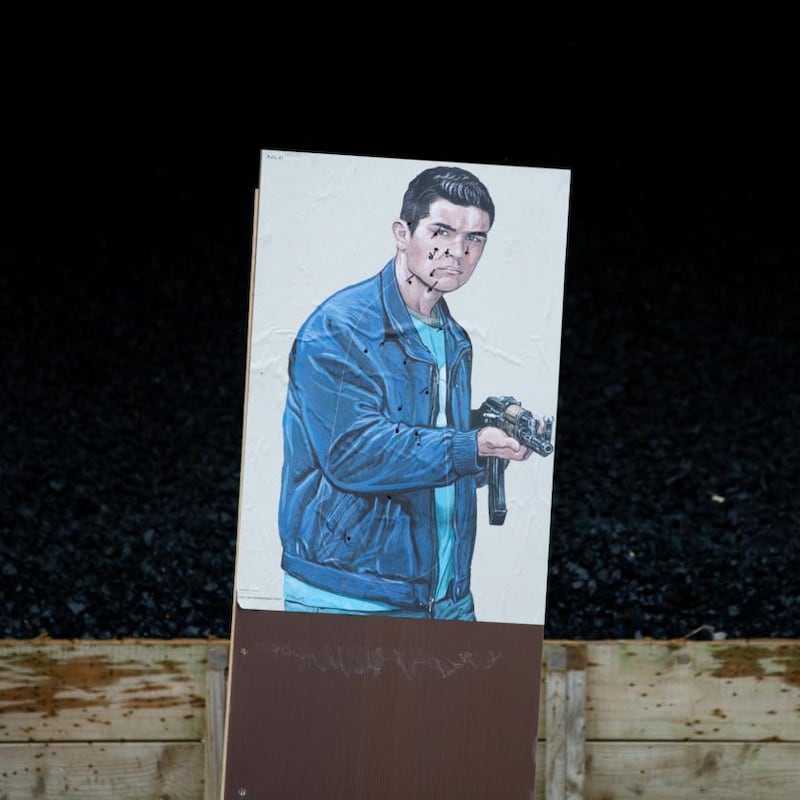
Slowly but surely IED causalities began to decrease among international personnel and members of the Afghan security services, Lane says. The change came first in Kabul and then in surrounding areas.
Lane also placed an increased emphasis on finding out where the bombs were coming from. Most of the devices were crude and mass-produced, with each component made in a different village.
“I spent a huge amount of time following people in villages, tracing them, watching them bring their kids to school, watching who they spoke to. You would put a whole social network together and then – bang – you find out that this particular pressure plate is being made in that particular village.”
The person manufacturing the component is then “removed from the battle space”, Lane says euphemistically.
“And that was the end of that particular pressure plate. Unfortunately, about 10 weeks later, it would appear somewhere else.”
For Lane, this initial casual attitude towards the IED threat stood in stark contrast to his experience as an ordnance officer in the Defence Forces.
Even as it cut other services to the bone over the years, the Irish military placed a high priority on bomb disposal and counter-IED tactics, even before anyone was using the phrase “IED”.
Each year representatives from dozens of militaries and police forces visit the Ordnance School in the Curragh Camp in Kildare for training courses and lectures while the UN regularly request the contribution of Irish ordnance experts on its missions.
Ordnance Corps personnel are currently deployed in Mali, training the national security forces there in counter-IED tactics as part of an EU mission.
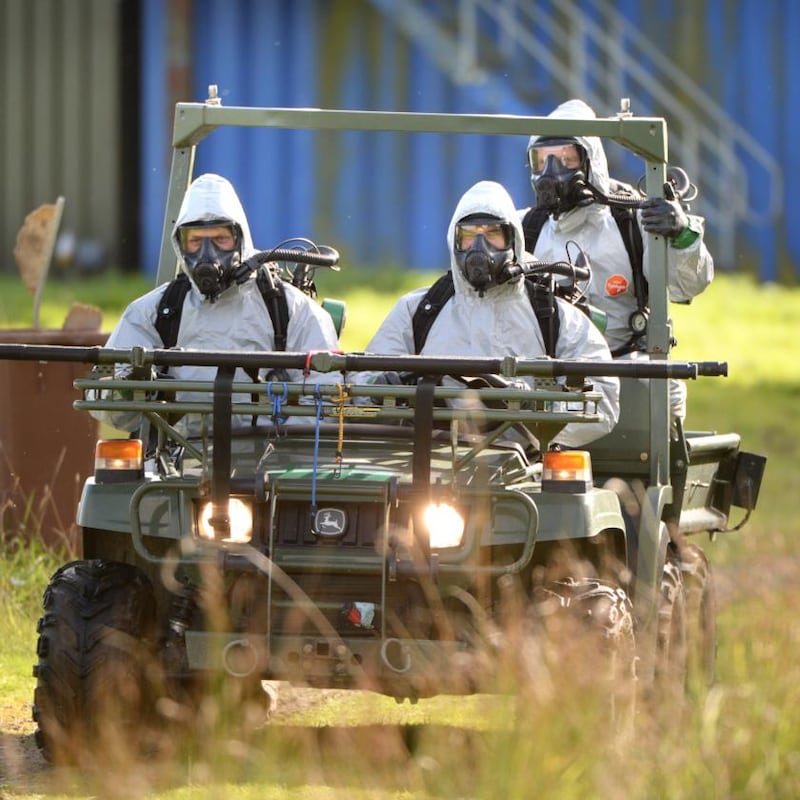
It wasn’t always like this. Lane was in training to become an officer in 1974 when the Dublin and Monaghan bombings took place leaving 34 dead and 300 injured.
In the hours and days after the bombs the Army’s Ordnance Corps, wearing only motorcycle helmets for protection, responded to many false alarms called in by members of the public .
“They had nothing, they had to borrow the helmets before going out,” says Lane. “I mean, those guys deserved medals for that. They were remarkable people.”
The danger they faced was very real. It later transpired the UVF had planted another two bombs in Dublin that day which had failed to go off, one in Busáras and one in a public Toilet on Amiens Street. They were found only months later.
Lane, who already held a degree in chemistry, was first posted to 12 Battalion in Limerick before joining the Ordnance Corps in 1979 under the command of Lt Col Tommy “The Bomb” O’Donnell.
He joined at a transformative time. The Dublin and Monaghan bombings had “lit a major fire” under the Defence Forces, he says, and a decision had been made to get serious about bomb disposal.
I'm up there looking at something on the ground and I'm asking myself, how does the guy who designed that make it better? What will the next one look like?
Ireland’s first bomb robot, nicknamed Elvis, was designed and built in the mid-1970s by Captain Patrick Boyle using pram wheels, windscreen wiper motors and other items retrieved from a car scrapyard. The total cost was £18, which Boyle paid out of his own pocket.
Its only purpose was to drop a small explosive charge beside a bomb to destroy its detonator. At the time the British were already using the more advanced Wheelbarrow robot but refused to share the technology. They relented later in the decade and the Ordnance Corps got its first Wheelbarrow. Elvis left the building, having been deployed just once, to examine a suspect device outside Cork Courthouse.
In later years Irish companies would develop robots specifically for the Defence Forces. The Hobo came first, followed shortly afterwards by the much larger Vagabond.
At the same time the Defence Forces placed an increased emphasis on research and trying to out-think paramilitary bombmakers. Despite the Dublin and Monaghan bombings being carried out by the UVF (with the possible collusion of the UK security forces), the Ordnance Corps chief adversary in terms of expertise was the Provisional IRA which were using the Republic to build explosives for use in Northern Ireland.
“We were trying to keep ahead of what these people were developing. And then to develop tactics, techniques and procedures to mitigate and reduce the effects of these devices,” Lane says.
Lane and his colleagues regularly travelled to Border regions to study IRA devices that had been seized by the gardaí. In some ways the work involved thinking like a terrorist.
“The question I’d ask myself is what is the next stage. I’m up there looking at something on the ground and I’m asking myself, how does the guy who designed that make it better? What will the next one look like?”
On the wall of the first floor of the Ordnance school is a black and white photograph of a young Ray Lane and two other men standing on a country road. There’s no date but the uniforms suggest it was taken sometime in the 1980s.
Lane is holding a massive black metal tube and is the only one of the three smiling. The caption reads “Doing something with a Mark Ten.”
“I’ll show you the real thing,” Lane says when he spots us looking at the photo before leading the way to a shipping container on the other side of the parade ground. He’s joined by Lieut Col Neil Kelly, who took over as head of the Ordnance School on Lane’s retirement last year.
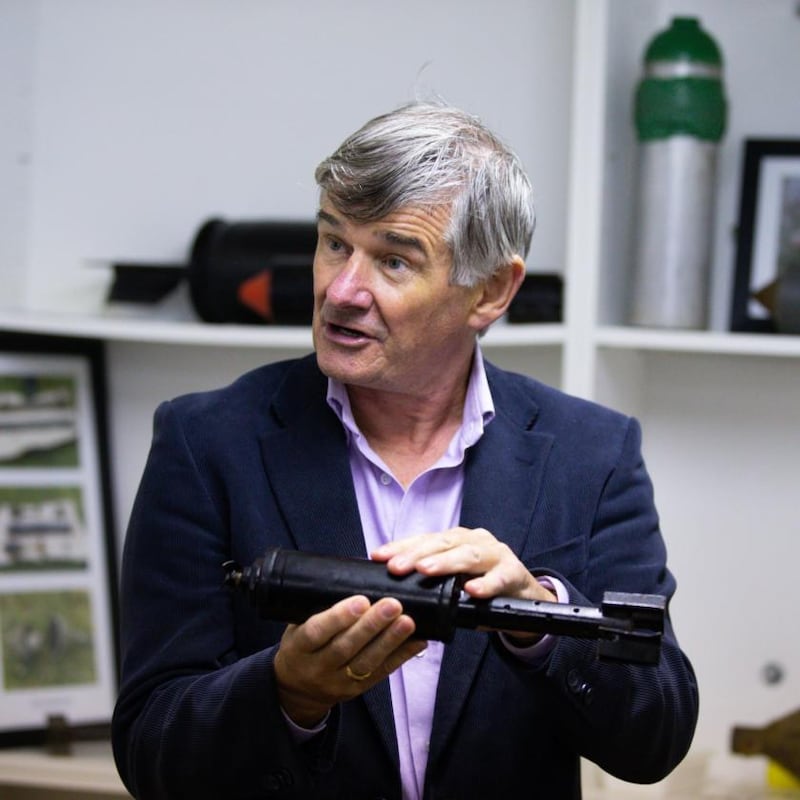
The first thing to grab the eye on entering is a crude “suicide vest” on a mannequin. The next thing is the shelves and boxes, which seem to contain every kind of explosive device imaginable (all decommissioned).
Lane goes straight to a huge metal tube – the same one he’s holding in the photograph. “This is the Mark Ten,” he says while hauling the tube upright. It is one of several found in the back of a Transit van which was being transported across the Border when it was seized by gardaí.
The van itself was part of the weapons system, Lane explains as he gestures towards a large wooden box which looks like a radio from the 1940s.
The driver of the van would park it in a pre-designated position and consult a colour-coded card before flicking the relevant switches on the wooden box. “It was colour coded, so even a fool could do it,” Lane says.
This would start a timer, giving the bomber plenty of time to get the bicycle from the back of the van and cycle away.
Thirty-five minutes later the mortar on the far left would fire, followed two seconds later by the one on the far right, each one carrying up to 35kgs of homemade explosives.
The tubes continued firing from the outside in. It set up like this to avoid unbalancing the truck and messing up the targeting, Lane explains.
Once all the bombs were fired, the truck’s cab blew up, “destroying all the forensic evidence.”
Eager to show off their grim handiwork, the IRA launched twelve mortars at Heathrow Airport over the course of five days in March 1994
The Mark Ten was one of the Provisional IRA's most devastating weapons. In 1985 it was used in a mortar attack on an RUC Barracks in Newry, killing nine officers and injuring 40.
It was also used in the attack on 10 Downing Street in 1991 in an attempt to assassinate then-prime minister John Major and members of his cabinet. One of the bombs landed in the back garden.
The device was dubbed the Mark Ten because it was the latest iteration of a series of sophisticated weapons developed by the IRA’s engineering cells.
Each change would improve range, payload or safety (for the operator).
For example, a previous version of the Mark Ten contained a serious flaw; if the firing mechanism failed the mortar would blow up in its tube after a certain time, killing anybody unlucky enough to be standing nearby. “These were normally fired from friendly areas. So if they didn’t fix it they wouldn’t have friends for very long,” Lane says. The IRA installed a mechanism that armed the mortar only after it left the tube.
The technological changes were “brilliant” but deadly. Lane picks up what he calls a Mark Six and a Mark Seven. The only difference between the two is a series of ridges on the side of the Mark Seven.
“These increase fragmentation. Instead of getting five or six fragments, you get 150 to 200.”
The same bomb has a strange metal spiral at the top. This, Lane explains, was twisted by the wind resistance after the bomb was fired. Once the spiral rotated two and a half times the bomb was armed.
Eager to show off their grim handiwork, the IRA launched twelve mortars at Heathrow Airport over the course of five days in March 1994. None of the bombs went off, something Lane believes was intentional. “All the detonators were put in upside down. It was a message to say we can do this and next time we will.”
Most or all of these devices were conceived and made by one man, who Lane appears to know a lot about. He says he is a “genius” when it comes to explosive devices despite having no technical training and little formal education. “He sits in library all day reading manuals about this stuff, just reading,” Lane says.
This man, along with two assistants “who were handy with their hands”, formed a tiny research and development group within the IRA tasked with coming up with ever-more effective ways of killing people without putting their own people in harm’s way.
“They were given specifics, they were told to look at developing bombs and other types of improvised explosives. But the one area where they made really great strides was in the whole area of mortar bombs.”
Lane gestures towards another tube device. It’s different from the others in that it is horizontal rather than vertical. This is the Mark 16, the final mortar made by the cell before the ceasefire of 1994.
In fact it’s not quite a mortar, Lane explains. “The Provos called it a mortar but that’s not accurate as it runs parallel to the ground.”
The weapon fires contains a “shaped charge” capable of penetrating thick armour. “You don’t make [a shaped charge] accidentally. you have to know the maths, the physics. There’s a lot in it and you have to get it right.”
On March 27th, 1993 the IRA left a parked a car by Merchants Quay in Newry. Inside the car was a Mark 16 mortar pointing out through a hole cut out of the body of the vehicle. This was rigged to a light sensor attached to the car’s rear-view mirror, Lane says.
The IRA knew an armoured RUC vehicle passed by that spot at the same time every day. That day it was carrying two young officers, Constables Colleen McMurray and Paul Slaine.
The IRA had recently developed the ability to detonate explosives using flashes of light, a technology developed in part by a British intelligence agent working undercover in the organisation.
As the RUC vehicle passed by that afternoon someone standing at the other side of the canal activated a camera flash. This hit the sensor on the car’s rear view mirror, firing the mortar and destroying the armoured RUC vehicle. McMurray was killed instantly and Slaine lost both of his legs.
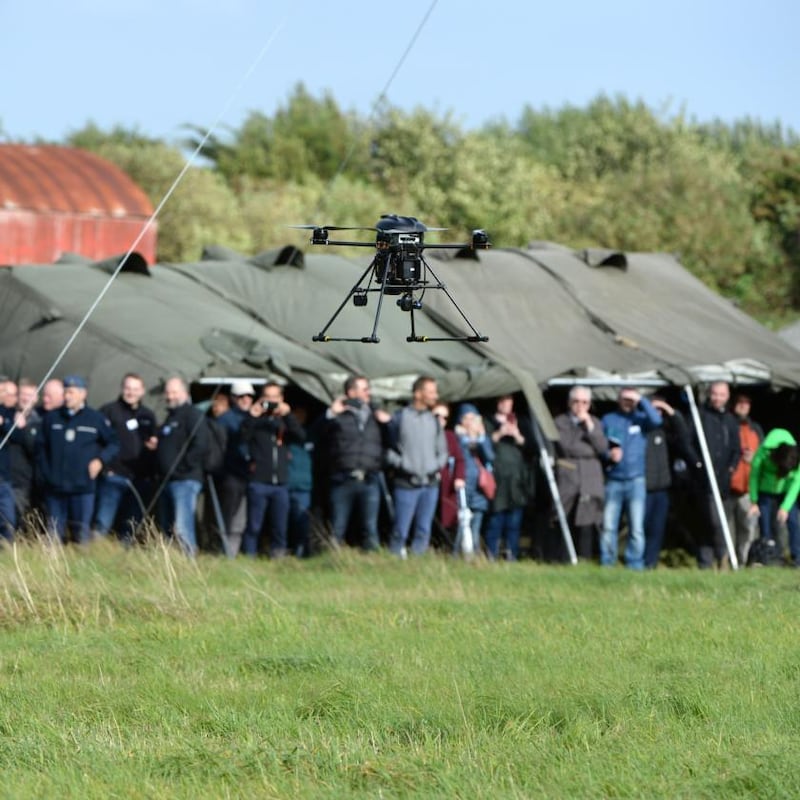
Listening to Lane speak about these devices, you could be forgiven for thinking he holds some admiration for its manufacturers. This would be a mistake, he says, something which becomes evident when he recalls the young ages of some of the people killed by these devices.
“I don’t admire these people. Sometimes you have to say to yourself ‘yea, this is effective technology’ but I don’t admire them.”
The man behind the Mark 16 was just one of a number of technicians developing improvised weapons, including mines, grenades and rocket launchers, for the IRA. Importing guns and bullets was never much of a problem during the Troubles but it was nearly always easier and cheaper for them to build the explosives themselves.
As an example, Lane holds up another device, the Projector Recoilless Improvised Grenade or Prig, which was developed by the group in the early 1990s.
It’s warhead is a tin can, packed full of explosives, with stabilising fins fitted to the end. “All the parts can be purchased in a hardware shop.”
Previous IRA explosive launchers had a massive kickback when fired which often left tell-tale bruises on the shoulder of the user. According to Tony Geraghty, author The Irish War: The Hidden Conflict Between the IRA and British Intelligence, British forces could occasionally identify exactly who had fired at them by making suspects show them their shoulders.
The group needed a weapon which produced much less recoil, Lane explains. It also needed one that could be fired from tight spaces so having the firing charge escape out the back was not an option.
They experimented with different biscuits and decided McVities Digestives were the best. The biscuits were placed in the tube. As the recoil and flash came back the biscuits broke, increased in surface area and absorbed the shock
The Prig solved both of these issues by incorporating a packet of biscuits into its design.
“They experimented with different biscuits and decided McVities Digestives were the best. The biscuits were placed in the tube. As the recoil and flash came back the biscuits broke, increased in surface area and absorbed the shock.
“I have fired these things and I can tell you, even with the biscuits in them, it’s still difficult. So they eventually moved to hard jelly. And that absorbed most of the recoil. The jelly would just drip out the end afterwards.”
Many of these weapons were designed to be stored for a long period of time without degrading. Lane holds up another item, the “improvised anti-armour hand grenade”. It came in two colours, blue for training models, yellow for live ones; “just like the Defence Forces,” notes Lane.
The bombs were sealed up in Wavin pipes and buried throughout the countryside, where they could remain for years before being dug up and used. “And they would work perfectly.”
The devices on the other side of the shipping container are of a visibly different nature. They’re less well machined and generally nastier in appearance.
There are large flat packets of ball bearings, designed to be worn by a suicide bomber and thrown out at high speed by the blast, and tank shells wired to go off as a vehicle or patrol passes by.
Some are so basic as to be almost comical. There’s a Pringles packet containing a can of fizzy orange with wires coming out connecting to a nine-volt battery. But all are just as deadly, if not more so, than the IRA’s arsenal.
These are examples of explosive devices (either decommissioned or mocked-up) found in the middle east and Afghanistan, some of which Lane has encountered personally.
The difference in appearance is down to priorities. Insurgent groups operating in Iraq and Afghanistan required scale, not sophistication.
“At the height of the Troubles we might have had 300 or 350 IED incidents in the 32 counties,” Lane says. In the year I was there, Afghanistan had 57,000. But the sophistication was not on a par with the Troubles.
That’s not to say sophistication was completely lacking. Lane points towards what appears to be a section of tree trunk. He lifts off the top and reveals the mechanism of a bomb which would be activated by someone walking on it. “All wood. If you have a metal detector it wouldn’t go off. A single village would be tasked with producing hundreds of these.”
Research was only one element of Lane’s 46-year career. He also spent a surprising amount time in court. In 2007 he gave evidence at the International Criminal Tribunal for the former Yugoslavia (ICTY) in the Hague. Lane testified about his dealings with one of the accused, former Bosnian politician Jadranko Prlic while he was head of the EU Monitoring Mission in Yugoslavia. Prlic and his co-accused were later convicted of war crimes.
In 2009 Lane testified at the Goldstone enquiry which was set up by the UN to investigate Israel’s use of force during the 2008-2009 Gaza War. He provided expert evidence on the use of weapons by both sides in the conflict, including Israel’s use of white phosphorous and flechette rounds.
Lane has also found himself in the “blast suit” many times, the nickname for the massive green blast suit worn by bomb-disposal technicians. How do you work up the courage to approach a device specifically designed to murder people? Or indeed, order someone else to do it? Lane says the answer is training, lots of training.
“The most difficult course to get through in the Defence Forces in unquestionably the EOD [Explosive Ordnance Disposal] course because you’re not just tested physically, you’re tested mentally.
“Before we put the imprimatur on the guy’s name to say he’s qualified, by God do we know him. Psychologically we know every little thing. The people who get through the course, I call them the premier team.”
According to Lane, the proof of this lies in the fact that over the last 45 years the EOD team hasn’t suffered a single fatality. “Although there have been a few incidents,” he concedes.
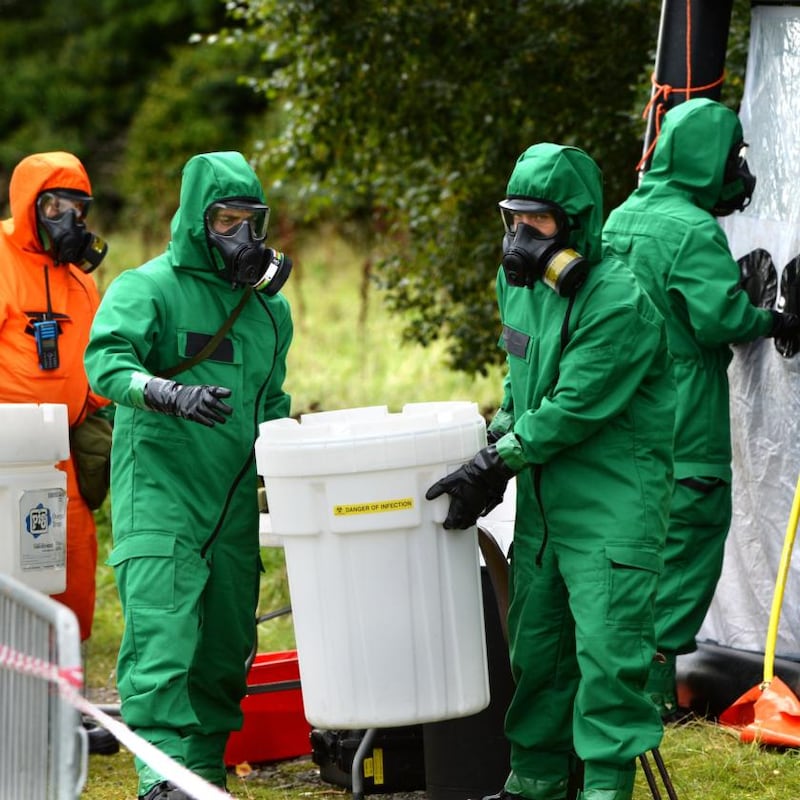
Bomb disposal technicians call it “the long walk”, the slow, lonely approach of a technician sent to examine a device.
Robots are gradually eliminating the necessity of the long walk but, according to Lane, it will be required for some time to come. “Terrorists want to make life difficult for us so they’re going to put the bomb somewhere we can’t send a robot.”
Nevertheless, the less time a human has to spend around a live device, the better.
On a rainy Monday morning in a field behind Casement Aerodrome in south-west Dublin, a huge video screen plays footage of a news report describing the release of a chemical agent at a Rod Stewart Concert in the city. Three people are dead and an unknown number have been exposed to the substance, the newsreader says in an oddly detached tone.
The (fake) news broadcast is played to add a level of realism to the demonstration being put on by the Defence Forces and experts from NUIG to showcase Irish capabilities in dealing with a Chemical Biological Radiological and Nuclear (CBRN) attack. Many experts fear such attacks are the future of terrorism and that Western nations are universally ill equipped to deal with them.
The focus of the demonstration, which took place in mid-September, was on the use of robotics and artificial intelligence (AI) to examine how devices and gather evidence.
From a command centre festooned with screens and communications equipment, technicians deploy an unmanned aerial vehicle (UAV) to examine the area from above (in the scenario a shipping container and some bins is standing in for the concert venue). An AI programme examines the images sent back by the UAV and in seconds identifies a suitcase likely to be linked to the chemical attack.
A robot known as the Reacher is then deployed to take samples from the site using a metal arm holding a tiny swab. The robot then brings the swab back to EOD personnel clad in orange and green hazmat suits who place it in a secure container.
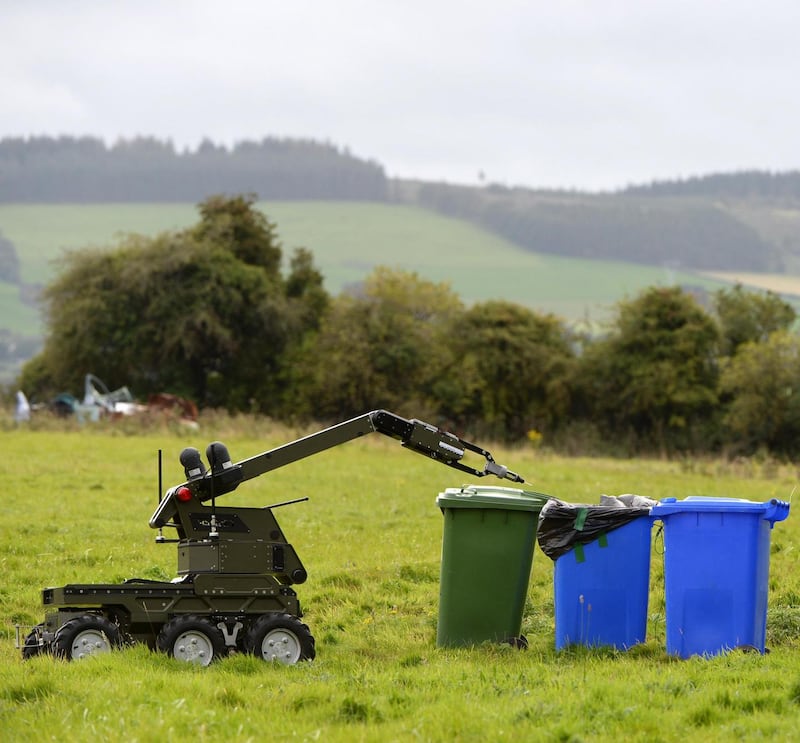
A similar exercise is carried out after the news reader announces authorities have located the laboratory used by the “Revolutionary Brotherhood” terrorists to manufacture the device. Again the UAV and robot go in to take samples.
The point of the exercises is to show the ability of the Ordnance Corps to analyse sites and gather vital evidence, all without having to endanger its own personnel.
Nuclear and chemical attacks are a possible future threat to Irish security. A threat that’s already here, says Lane, is that of the “marauding terrorist”. These attacks tend to be much more dangerous than conventional bomb attacks in that they often involve several elements, such as firearms, explosives or vehicles and, crucially, the terrorist is nearly always prepared to die while carrying them out.
In the early 2010s Lane sought to develop the school’s counter-IED expertise into stopping or mitigating marauding terrorist attacks. When the first Nato Commanders Counter Marauding Terrorist Attack took place at the Curragh Camp that year, it was ahead of its time.
At that point such attacks were almost unheard of in Europe. At few months after the first course, Islamic terrorists attacked the offices of Charlie Hebdo magazine in Paris, France, sparking off a series of events which would leave 20 dead across the city. Suddenly the efforts of Lane and his colleagues seemed much more relevant.
In late September, an international group consisting of, among others, soldiers, police officers, prison staff and FBI agents, gather in the Curragh for the fourth iteration of the course. Lane is on hand to offer guidance but, for the first time, as a civilian and not an officer.
The first day involves a series of tests of the participants’ abilities and situational awareness. The results are mixed. One exercise involves administering first aid to an injured woman who may or may not be a terrorist.
Most students instantly spot the grenade in her hand but few realise she is concealing an handgun under her top. Next they have to strip, reassemble and then fire an AKM assault rifle, the type of firearm most likely to be used in a major terrorist gun attack.
Everyone manages to unload the rifle but many have trouble putting it back together. An attempt by an American agent to reassemble and fire the gun ends with its top cover flying off.
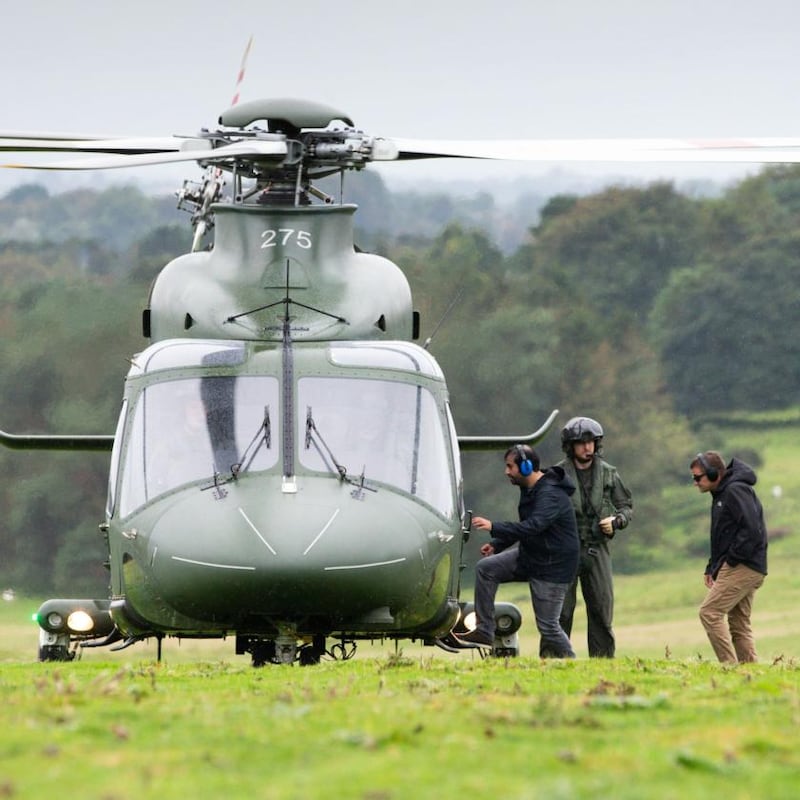
More exercises follow, including firing a pistol from behind cover and co-ordinating the emergency service response to a fictional attack on a Carlow church.
“These are just evaluation exercises to get a sense of where they are in terms of knowledge,” one of the instructors explains. “They’re not expected to know everything yet.”
Four more days of exercises, lectures and training will follow, including, on Wednesday, a trip to Dublin Zoo to “war game” the potential for a terrorist attack.
Chemical and marauding terrorist attacks are extreme events that Ireland has been fortunate enough to avoid to date. A far more immediate threat is that posed by organised criminal gangs, which are increasingly using explosive devices, usually crude pipe bombs, to target their enemies.
In 2018, teams were deployed 70 times to examine or defuse suspect devices, many of which were planted by feuding gangs. When a viable device is located the bomb robot is typically deployed to examine it and then shoot a high velocity jet of water at the detonator, rending it useless.
The bombs rarely kill, Lane says, “but their psychological impact is immense.”
Asked what his biggest fear is for the future, Lane takes a moment to think before responding. He says he’s not afraid that a hard border with the North would bring the island back to the bad old days of the 1970s. There’s not a chance in hell of that, although it suits some people to say there is.”
Lane is more troubled by the prospect of organised criminals in the Republic figuring out how to make effective IEDs and possibly pay for the expertise of the “old Provos” to help them.
“Nobody wants to pull the trigger if they can plant a bomb instead. My fear is someday they match their intent with some of the Provos’ capabilities. And then we’re all in big trouble.”




















